 The automated control
The automated control

How does it work?
The diagram below briefly describes the steps of the "automated control" system from the recording of the offence by the camera, the despatching of the fine to the residence and the payment or appeal options.
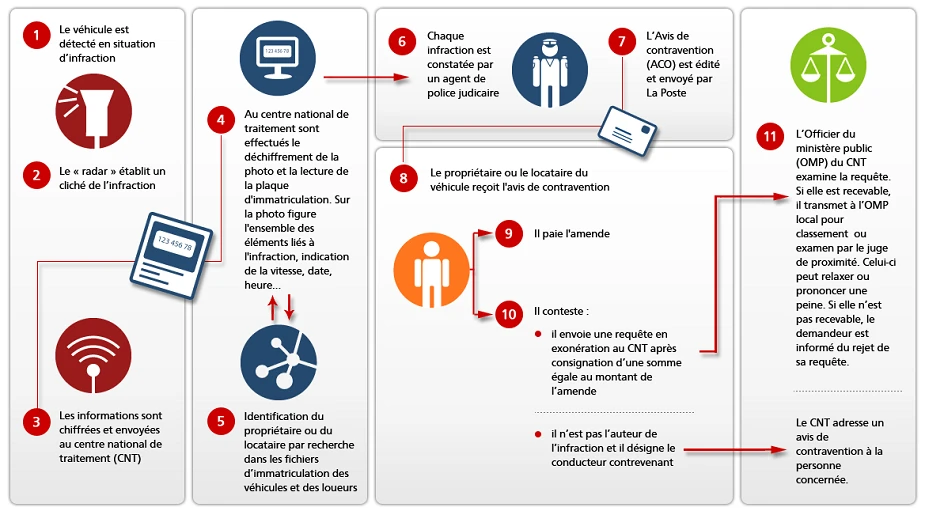
Understanding the different types of speed cameras and how they work
Fixed speed cameras
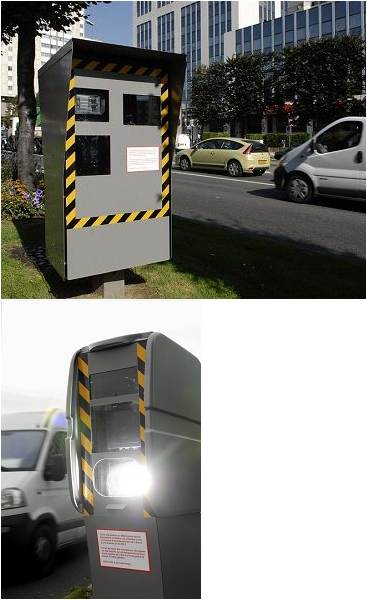
Description:
This was the first type of camera to be installed. It checks the speed of drivers in the most dangerous or accident-heavy areas with the aim of reducing speed and hence road traffic accidents.
Technical margin:
A margin of 5 km/h (below 100 km/h) or 5% (below 100 km/h) is taken into account, always in favour of the driver.
It is therefore impossible to be penalized for "insignificant" speeding, since this margin must always be added.
Example: you are recorded at a speed of 97 km/h, the figure used is 92 km/h.
Signage:
Fixed speed cameras can be indicated by speed camera signs. Find out more on the Légifrance website
Installation:
Fixed speed cameras are installed on sites recommended by the Préfet of the département according to the following criteria:
- areas where accidents occur that are mainly caused by speeding;
- at regular intervals over main roads to bring down the average speed over the whole route;
- areas in which users must pay extra attention, particularly sections of road where redevelopment would be difficult to make or extremely expensive (tunnels, bridges);
- in places and sections of road where police cannot be present to carry out traditional speed checks.
The discriminating speed camera (HGV)
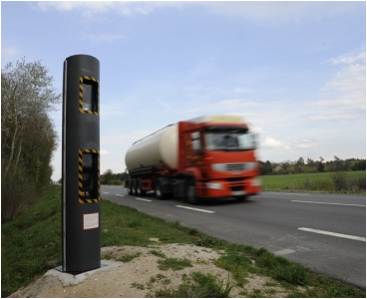
Description:
This is a fixed speed camera that distinguishes categories of vehicles, and particularly heavy goods vehicles, in order to check specific speed limits according to the category of user. It is also used to identify the offending vehicle with certainty in the event of several appearing in one photograph. This equipment is equipped with 3 modules allowing the measurement of the speed, the Light/Heavy Vehicle and the identification of the lane.
Technical margin:
As for the fixed speed camera, a margin of 5 km/h (below 100 km/h) or 5% (above 100 km/h) is taken into account, always in favour of the driver.
It is therefore impossible to be punished for "insignificant" speeding, since this margin must always be added.
Example: you are recorded at a speed of 97 km/h, the figure used is 92 km/h.
Signage:
Fixed speed cameras can be indicated by speed camera signs. Find out more on the Légifrance website
Installation:
It is intended to be installed mainly on routes where HGV traffic is considerable:
- areas where accidents occur that are mainly caused by speeding;
- main roads with heavy HGV traffic, on which the speed limit is often ignored;
- particular sections of road (dangerous downward slope, series of turns, road passing through an urban area etc.) justifying particularly strict checking;
- places and road sections where the police cannot be present to carry out traditional speed checks.
Mobile speed camera
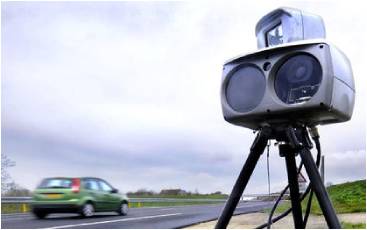
Description:
Camera installed in a vehicle stopped and positioned at the roadside, which detects and records speeding.
Technical margin:
As for the fixed speed camera, a margin of 5 km/h (below 100 km/h) or 5% (above 100 km/h) is taken into account, always in favour of the driver.
It is therefore impossible to be punished for "insignificant" speeding, since this margin must always be added.
Example: you are recorded at a speed of 97 km/h, the figure used is 92 km/h.
Signage:
These cameras are not indicated on roads, unlike fixed speed cameras. More flexible, they can be used to check speeds anywhere and to adapt to circumstances when required (roadworks, traffic conditions.) They encourage careful driving.
Installation:
The choices of checkpoint are decided by the Préfets of the département working with the police, according to the following criteria:
- areas where accidents occur that are mainly caused by speeding;
- at regular intervals over main roads to bring down the average speed over the whole route.
Autonomous speed camera
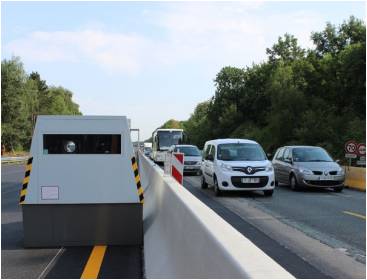
Description:
Used to provide speed checking adapted to roadworks sites where the speed limits are rarely obeyed, after an experiment with semi-fixed cameras in 2012, these devices are in use across the national road network and the toll motorway network.
They are moveable across different work and temporary danger areas and have a battery autonomy of one week. They are indicated by a "Radar check over whole length of worksite" panel combined with the worksite signage.
"Road section" average speed camera
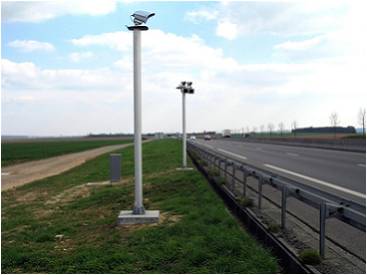
Description:
The "section" or "average speed" camera checks the average speed practised by users over a road section of several kilometres between two points, to prevent vehicles from suddenly slowing down excessively in front of fixed cameras, and encourage users to drive responsibly throughout their journey.
The place of the offence is the exit checkpoint. At each checkpoint (entering and exiting the monitored section), a video camera, associated with an automatic number plate reader, takes a shot of each vehicle and records its number plate and time of passage. At the exit point, a processing unit uses this information for each vehicle to compute its average speed over the section.
Signage:
Fixed speed cameras can be indicated by speed camera signs. Find out more on the Légifrance website
Technical margin:
As for the fixed speed camera, a margin of 5 km/h (below 100 km/h) or 5% (above 100 km/h) is taken into account, always in favour of the driver.
It is therefore impossible to be punished for "insignificant" speeding, since this margin must always be added.
Example: you are recorded at a speed of 97 km/h, the figure used is 92 km/h.
Installation:
These road section radars are intended for dangerous sections of road or motorway (turns, downward slopes etc.) or sections on which an accident would have aggravated consequences (bridges, tunnels, viaducts, etc.).
Red light "camera"
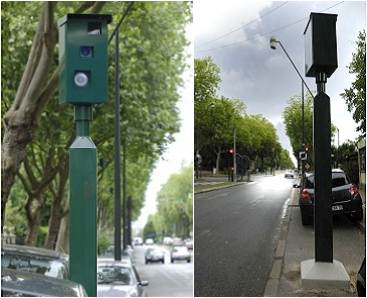
Description:
Detects and records offences committed at traffic lights. Two photos are taken, the first if a vehicle crosses the traffic light stop line and the second if the vehicle continues driving beyond the traffic light. It is an essential tool to improve protection of users exposed to crossroads.
The flash is triggered when a vehicle goes beyond the traffic light stop line, which is identified by a dotted line on the road. The Traffic regulation requires the driver to stop before the traffic light stop line. The fact that the driver is straddling or crossing this line is considered as an offence.
Technical margin:
If the vehicle crosses the traffic light stop line but stops at the traffic light just before the crossroads, the camera will be triggered but the offence ticket will not be sent.
Moreover, if a long vehicle passes when the light when on green or orange but the trailer passes when the light is red, the flash will not be triggered.
Signage:
Red light "cameras" are not preceded by any sign for several reasons:
- the traffic light is a signalling system,
- too many signs likely to impede visibility are installed in the urban environment.
Installation:
They are installed in dense urban areas in order to protect the most exposed users near:
- areas with pedestrians (near schools or leisure centres, retirement homes, town centres…);
- dangerous crossings (near railway crossings or tramway crossings, major crossroads with traffic lights…);
- main roads and urban crossings.
Level crossing "camera"
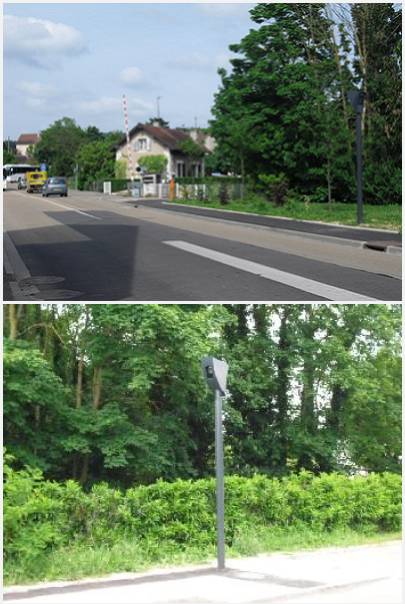
Description:
The checking system is more or less the same as that used to detect driving through a red light. The main difference lies in the flashing orange sign at railway crossings. A second light then operates alternately so that each shot establishing the offence shows the light.
A photograph of the users passing the railway crossing after the safety period is then taken:
- a first time when they pass the line;
- a second time when they continue their course on the railway crossing, whether they are in their lane (direct crossing) or in the adjacent lane (crossing driving round the barriers).
Technical margin:
In order to allow users to stop safely to respect the flashing sign, a safety period similar to the orange light for traffic lights is configured in the equipment. This period will be 3 seconds in urban areas and 5 seconds outside of urban areas. Illegal crossings will only trigger the camera flash after this period.
Signage:
Railway crossing "cameras" are not indicated for several reasons:
- the flashing light is already a sign;
- the level crossing is also indicated.
Installation:
Railway crossing "cameras" are installed on the main railway crossings, the criteria for which are defined with French rail network and SNCF.
New-generation mobile camera
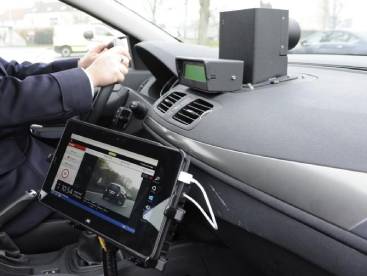
Description:
A "new-generation mobile camera" (also known as ETM - mobile terrain equipment) is a device installed on an unmarked patrol car, driven by uniformed gendarmes or police officers. Its function is to photograph all speeding vehicles, with no visible flash and while driving.
Signage:
These cameras are not indicated on these roads: these new systems are integrated into unmarked vehicles and use an infra-red flash, invisible to flashed users.
Technical margin:
These radars are designed to target drivers driving well above the speed limit: the technical margin of these cameras is 10km/h for speed limits below 100 km/h and 10% for speed limits above 100 km/h (as opposed to 5 km/h and 5% for other speed cameras).
Thus, vehicles will be flashed when driving at over 146 km/h on motorways, 124 km/h on express lanes, 102 km/h on "national road" or "departmental road" roads or 61 km/h in urban areas.
Information camera
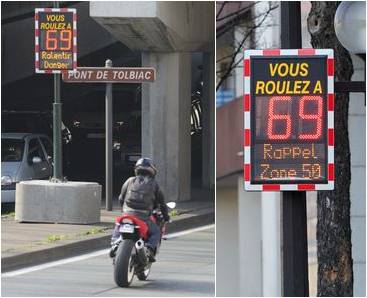
Description:
These devices inform drivers of their speed without penalizing them, to encourage them to adapt their behaviour.
Functionality:
It displays the speed, in green if the user is within the limit, red above up to a maximum threshold (generally 20km/h above the limit.) It also displays an information message that changes according to the measured speed: SLOW DOWN then DANGER, to encourage users to adapt their behaviour.
Installation:
Information cameras are installed upstream of all fixed cameras, at a random distance according to the configuration of the location, or in danger areas where there is no fixed camera.
Following the decision of the Ministre de l'Intérieur, on 15th February 2013, to return to consistency in speed camera signage, speed camera signs have been phased in to indicate fixed speed cameras. Information cameras previously installed upstream of fixed cameras and removed will be redeployed to danger areas not equipped with automatic cameras.
Thus the removal of information cameras placed upstream of existing cameras and their replacement by speed camera signs, begun in April 2013, is now complete. Information cameras in good working condition will be reinstalled in danger areas where there is no fixed camera.
Le parc de radars en France
Pour visualiser la répartition géographique des radars en France, vous pouvez consulter la carte des radars sur le site de la sécurité routière.
Au 01 Janvier 2023, la France compte 4530 radars de tous types.
L'infographie suivante présente leur répartition par type.
REPARTITION DU PARC DE RADARS DEPLOYES AU 1er JANVIER 2023
Répartition du parc de radars par typologie en 2022
Pour en savoir plus sur la Délégation à la sécurité routière et la réglementation des limitations de vitesse :
- Historique des radars et textes utiles, site de la Sécurité routière.
- Les radars en chiffres, site de la Sécurité routière.
- 20 ans de radars automatiques, brochure de la Sécurité routière.




















